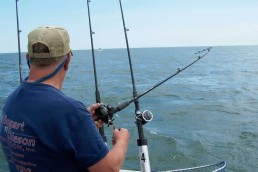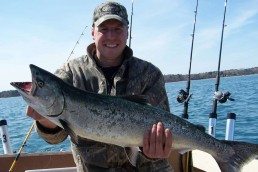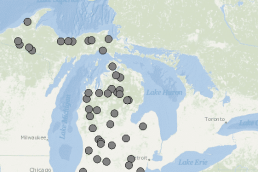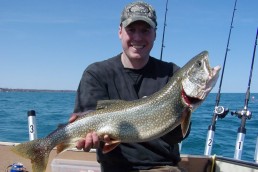Rest of Summer Looks to be Great on the Great Lakes
SHARE THIS POST
With the unusual winter, and despite invasive species continuing to impact the Great Lakes, anglers can expect to find excellent fishing conditions this season.
Lake Superior
“The relatively mild winter increases the number of days (spring and summer) anglers are able to get out on the lake, and this can be an especially productive time to fish,” said Philip Schneeberger, DNR basin coordinator for Lake Superior. “More than 18 different fish species regularly show up in creel surveys on Lake Superior. Lake whitefish and lake trout are almost always at the top of the list numerically, but anglers also successfully target coho salmon, cisco, pink salmon, chinook salmon, splake, steelhead, Atlantic salmon, brown trout, smallmouth bass, northern pike and several other sport fish.”
Schneeberger also noted that in 2015 angler harvests of brown trout, chinooks and lean lake trout were all above 10-year averages. He also offered some advice for those on Lake Superior.
“Anglers ply Lake Superior waters from shore, using small or large boats, casting, trolling or jigging. Favorite areas include bays, piers, breakwalls, river mouths, open water, nearshore and offshore reefs. Unique opportunities are found at Isle Royale, Stannard Rock or Big Reef.”
Stocking efforts this season are similar to previous years according to Schneeberger. He said 700,000 fish are to be stocked, including 15,000 yearling brown trout, 400,000 spring fingerling chinooks, 15,000 yearling and 50,000 fall fingerling rainbow trout, 85,000 yearling splake and 150,000 spring fingerling walleyes.
Lake Huron
Todd Grischke, DNR basin coordinator for Lake Huron, reports that anglers will continue to have many opportunities for a successful fishing season right out of the gate.
“Walleye fishing is expected to be excellent this year,” Grischke said. “Lake trout populations remain very good. Steelhead are already being reported in good numbers from the Ausable River and several other Lake Huron tributaries; a few Atlantic salmon have been (were) reported already this spring.”
Aside from the variation in weather conditions this past spring, the coordinator says fish migration patterns are on par with average years. This includes the walleye spawning runs and offshore fishing opportunities. He added higher water levels in the Great Lakes will likely benefit nearshore spawning fish populations.
A few fishing regulation changes will take into effect this season according to Grischke.
“In November of 2015 we initiated a regulation change for walleyes and yellow perch in MH-4, which includes the Great Lakes waters of Saginaw Bay. The regulation is in place for the 2016 fishing season and will be reevaluated each year. For walleyes, the minimum size limit was decreased from 15 to 13 inches and the daily bag limit was increased from five to eight fish. For yellow perch, the daily bag limit was reduced from 50 fish a day to 25 fish a day.”
Lake Michigan
“We expect fishing to be similar to last year with chinook salmon catches down compared to previous years,” according to Jay Wesley, DNR basin coordinator for Lake Michigan. “Lake trout numbers should be solid and catches of other species like steelhead, cohos and brown trout should be similar to past years.”
Are you enjoying this post?
You can be among the first to get the latest info on where to go, what to use and how to use it!
Colder spring weather earlier this year will likely slow fishing success for anglers in western Michigan early, but only temporarily. He noted that the spring water temperatures were colder, so they are slightly behind schedule for some fish movements. He also added the coho salmon and brown and lake trout fishing should be good near the shore, with action starting in the southern part of the lake and slowly moving north as the water continues to warm.
“Overall, fish will be smaller in size due to low prey biomass. Chinook salmon catches may be lower due to lower population. However, lake trout catches may be up and cohos, brown trout and steelhead should remain steady,” Wesley said.
Wesley reported the top three catches for anglers in 2015 were 45 percent for chinooks at 2 million pounds, 19 percent for lake trout at 800,000 pounds and 13 percent of catches were for steelhead at 570,000 pounds.
Stocking will be similar to last year with the exception of small yearling steelhead, with 66,000 into Lake Michigan.
“Lake-wide stocking expectations are 2.75 million lake trout, 2.6 million coho salmon, 1.8 million chinook salmon, 1.5 million steelhead and 1.4 million brown trout.”
Lake Erie
Anglers on Lake Erie can expect to find another great season when targeting perch and walleyes.
DNR Basin Coordinator for Lake Erie, Jim Francis, says both species have had strong recent year-classes, which will improve population numbers.
“We documented an average walleye year-class in 2014 and a very strong year-class in 2015—both of these will contribute to increases in walleye abundance on Lake Erie,” Francis said. “Similar to walleyes, there were good year-classes of yellow perch in both 2014 and 2015.”
He added these quality year-classes should translate into increased numbers of yellow perch in the Michigan waters of Lake Erie.
Although the size of perch and walleyes caught will be smaller, anglers will see an increase in their numbers.
“Perch will be primarily 2-year-old fish, so numbers will be up, but size of fish may be smaller than what anglers have been used to catching.”
He said although the size of walleyes that anglers catch over the next few years will be smaller than what they are used to, there will be a significant increase in numbers. MWO
MWO
SHARE THIS POST
Did you enjoy this post?
You can be among the first to get the latest info on where to go, what to use and how to use it!
Darin Potter
Darin Potter’s passion for outdoor writing began at the age of 12 when he first began writing in a journal that his parents bought him on a family camping trip in Northern Michigan. His writings have appeared in several Midwest publications: Michigan-Out-of-Doors, Michigan and Ohio Outdoor News, Modern Pioneer, and MidWest Outdoors.




